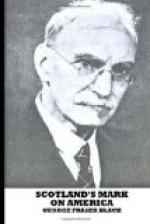The most famous family of Colonial times was that of the Livingstons of Livingston Manor, famed alike for their ability and their patriotism. The first of the family in America was Robert Livingston (1654-1725), born at Ancrum, Roxburghshire, who came to America about 1672. He married Alida (Schuyler) Van Rensselaer. His eldest son, Philip (1686-1749), second Lord of the Manor, succeeded him and added greatly to the family wealth and lands by his business enterprise. Peter Van Brugh Livingston (1710-92), second son of Philip, was President of the first Provincial Congress. Another son, Philip (1716-78), was Member of the General Assembly for the City of New York, Member of Congress in 1774 and 1776, and one of the Signers of the Declaration of Independence. A third son was William (1723-90), Governor of New Jersey. Other prominent members of this family were Robert R. Livingston (1746-1813), and Edward (1764-1836). The former was Member of the Continental Congress, Chancellor of the State of New York (1777-1801), Secretary of Foreign Affairs (1781-83), Minister to France (1801-05), and Negotiator of the Louisiana Purchase (1803). He administered the oath of office to George Washington on his assuming the office of President. Edward was Member of Congress from New York (1795-1801), Mayor of New York City (1801-03), Member of Congress from Louisiana (1823-29), United States Senator (1829-31), Secretary of State (1831-33), and Minister to France (1833-35). Robert Fulton, the inventor, married a daughter of the Livingstons and thus got the necessary financial backing to make the Clermont a success. A sister of Edward was married to General Montgomery of Quebec fame, another to Secretary of War Armstrong, and a third to General Morgan Lewis.
The Bells of New Hampshire descended from John Bell, the Londonderry settler of 1718, gave three governors to New Hampshire and one to Vermont. Luther V. Bell, formerly Superintendent of the McLean Asylum, Somerville, Massachusetts, was another of his descendants. The McNutts of Londonderry, New Hampshire, are descended from William McNaught, who settled there in 1718. The McNaughts came originally from Kilquhanite in Galloway. The Bean family, descended from John Bean who came to America in 1660, were pioneers in new settlements in New Hampshire and Maine, and bore the burden of such a life and profited by it. About one hundred of them were soldiers in the Revolutionary War. The Macdonough family of Delaware is also of Scottish descent. Thomas Macdonough, the famous naval officer, was of the third generation in this country. The Corbit family of Delaware are descended from Daniel Corbit, a Quaker born in Scotland in 1682. The Forsyths of Georgia are descended from Robert Forsyth, born in Scotland about 1754, who entered the Congressional Army and became a Captain of Lee’s Light Horse in 1776. The Forsyths of New York State trace their descent to two brothers from Aberdeenshire (John and Alexander). The bulk of the Virginia Gordons appear to have been from Galloway.




